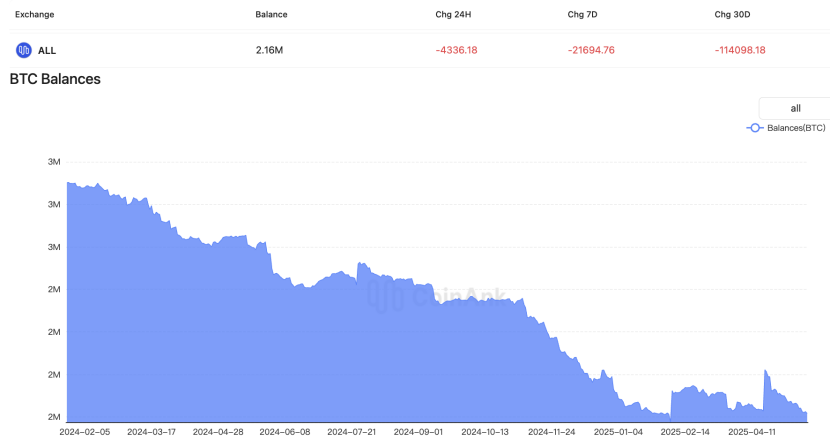Have the impacts of Moody's downgrade of the U.S. debt rating been digested? The three major driving forces and potential variables for BTC to hit $110,000
Macroeconomic Interpretation: Recently, Wall Street institutions have rarely reached a consensus, predicting that the European Stoxx 600 index will achieve a 25 percentage point excess return over the S&P 500 by 2025, marking a profound shift in global capital allocation. A Bank of America survey shows that the proportion of fund managers overweighting European stocks has reached 35%, while allocations to U.S. stocks have dropped to a two-year low. Behind this flow of funds is actually investors' risk-averse choice in response to the uncertainty of Federal Reserve policies. When the risk appetite in traditional financial markets shifts towards defensive assets, crypto assets often become beneficiaries of cross-market capital flows. Notably, Robert Kiyosaki, author of "Rich Dad Poor Dad," recently warned that Moody's potential downgrade of the U.S. debt rating could trigger rising interest rates and recession risks, and this macro-level concern is reinforcing Bitcoin's "digital gold" attribute. Historical data shows that during the S&P downgrade of the U.S. rating in 2011, gold prices soared by 18%, while the current institutionalization of Bitcoin is incomparable.
According to CoinAnk data, the current exchange balance of Bitcoin has dropped to a historical low of 7.1%, a decrease of 1.7 million coins compared to 2018. This persistent accumulation of chips indicates that long-term holders (LTH) have gained market dominance. More importantly, this round of rebound has not been accompanied by signs of overheating on-chain activity: there has been no massive token transfer as seen at the end of the 2021 bull market, nor high leverage in the derivatives market. Monitoring data shows that Bitcoin's implied volatility is at a multi-year low, and the perpetual contract funding rate is only slightly positive, contrasting sharply with the scene at the beginning of 2023 when retail investors were aggressively leveraging. Whale James Wynn points out that there is dense limit order support at the $100,000 level, with an enormous amount of buy orders accumulating in the $97,000 to $99,000 range. This market structure provides both short-term support and accumulates momentum for breaking previous highs.
The crypto market is undergoing a historic transformation: the SuperTrend indicator for the ETH/BTC trading pair has turned bullish for the first time since 2015, while Ethereum's exchange balance has fallen below 4.9%, a historical extreme. This dual signal suggests that Ethereum may be ending a three-year period of relative weakness. HTX Research Institute's Chloe notes that the current upward momentum of Bitcoin may spill over into quality altcoins, with emerging Layer 1 projects like the SUI ecosystem and the AttentionFi sector represented by Kaito attracting strategic institutional investments. It is worth noting that the divergence between call option premiums and implied volatility in the options market has reached a critical point—the 1.55 Call/Put open interest ratio indicates that market sentiment is overly optimistic, while the 35% short-term IV suggests that volatility suppression is unsustainable. This contradictory state could trigger two extreme movements: if Bitcoin effectively breaks through $105,000, it will trigger a wave of programmatic trading; conversely, if it loses key support levels, a chain liquidation of high-leverage positions could lead to a sharp drop of 10%-15%.
Despite many positive signals in the market, three potential risks must be heeded: first, the U.S. debt rating turmoil could trigger a global liquidity contraction, which would indiscriminately impact all risk assets; second, the total market size of stablecoins accounts for only 1.1% of the U.S. dollar M2, meaning it still falls within the high-beta asset category, with sensitivity to macro policies far exceeding that of traditional assets; finally, the miner holding index shows that some miners have begun hedging, and this movement of "smart money" often leads market price fluctuations. For investors, while maintaining core positions, it is advisable to allocate to RWA projects with actual cash flow support or choose volatility-related derivatives for risk hedging. As Kiyosaki said, true wealth creation often arises from the moments of crisis and opportunity transition, and the current crypto market is providing a rare layout window for astute observers.

BTC Data Analysis:
CoinAnk data shows that the exchange balance of Bitcoin has dropped to a historical low of 7.1%, shrinking by 1.7 million coins from the 2018 peak, forming the most significant "on-chain chip accumulation" phenomenon since 2015. The median holding period for long-term holders (LTH) has surpassed 4.2 years, and their holding proportion has risen to 63%, marking a shift in the market from speculation-driven to value storage paradigms. This round of price rebound has been accompanied by moderate growth in on-chain activity, with the average daily large transfer volume (>1000 BTC) being only 17% of that at the end of the 2021 bull market, and the derivatives leverage ratio (open interest/market cap ratio) stabilizing in a reasonable range of 0.85, showing no signs of overheating risk.
The dominance of long-term holders is reshaping market operating logic: first, the shrinking liquidity pool on exchanges has reduced the price volatility center to 45% (down 58% from 2021), limiting short-term speculative profit potential; second, the miner pressure index (MPI) has reached a three-year low of -0.91, combined with a 12% increase in hash rate post-halving, forming supply-side tightening support; finally, institutions are driving an average daily net inflow of $180 million through ETFs, promoting the formation of a dual-layer market structure of "cold storage-compliant products." However, liquidity layering risks must be heeded— the top 1% of addresses control 71% of the circulating supply, and if whales simultaneously reduce their holdings, it could trigger a 10% flash crash. The current Bitcoin options skew index (-24) has implied market pricing for downside risks. This cycle may exhibit "slow bull" characteristics, with historically high volatility premiums gradually yielding to an institutional pricing system.
免责声明:本文章仅代表作者个人观点,不代表本平台的立场和观点。本文章仅供信息分享,不构成对任何人的任何投资建议。用户与作者之间的任何争议,与本平台无关。如网页中刊载的文章或图片涉及侵权,请提供相关的权利证明和身份证明发送邮件到support@aicoin.com,本平台相关工作人员将会进行核查。



